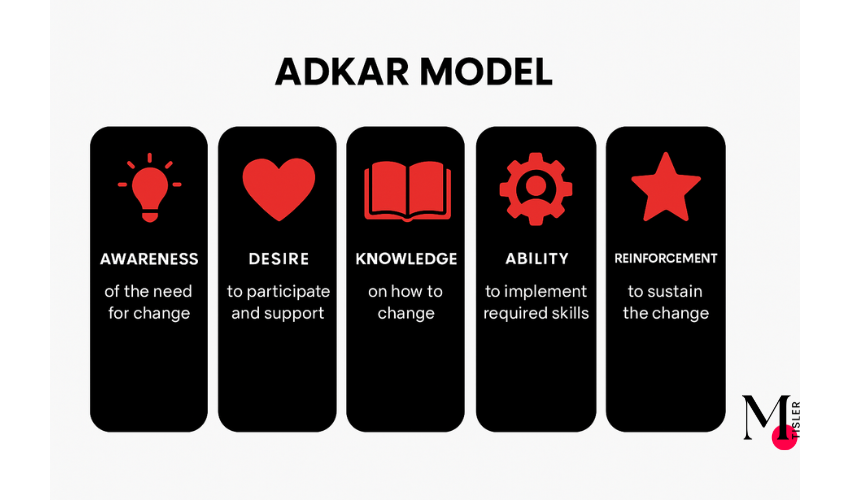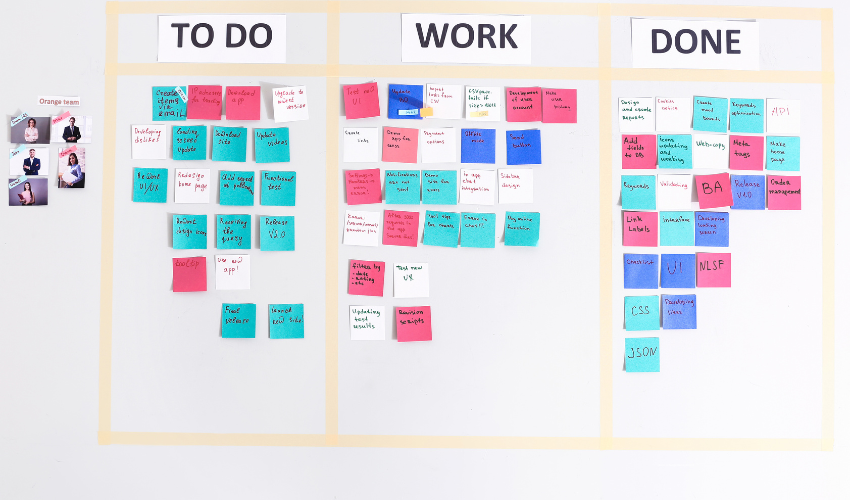Prosci Change Management Actually Has The Answers
Share it
Is Your Organization Prepared for the Challenges of Change?
Prosci change management is a practical methodology for helping people adopt change at work: without chaos, resistance, or backsliding. It’s often taught alongside the ADKAR model, which explains what individuals need to move from “this is happening to me” to “I can do this confidently.”
If you’ve heard “Prosci” or “ADKAR” in training and you’re not sure what the difference is, you’re not alone. In this guide, I’ll explain both in plain English, show how they fit together, and walk through the core steps you’ll see in real projects.
In this article, you’ll learn:
What Prosci change management is (and what it isn’t)
The ADKAR model steps (with a simple example)
Prosci vs ADKAR: how to choose what you need
The Prosci 3-phase process and the tools teams use to plan and measure change
What is Prosci Change Management?
Prosci change management is a structured, people-focused methodology that helps organizations prepare for, manage, and sustain change.
- Structured approach to managing organizational change
- Focuses on the people side of change
- Provides a comprehensive methodology and toolkit
By focusing on the people side of change, Prosci’s approach helps organizations build the readiness, commitment, and capability needed to achieve their desired results.
Want the bigger picture? Explore the importance of change management in projects, and see how structured change practices directly influence project outcomes, stakeholder buy-in, and long-term results.
What Is Prosci? (Simple Explanation)
Prosci is both a company and a change management methodology. The company develops research-based tools, training, and frameworks to help organizations manage the people side of change.
The ADKAR model is one part of the Prosci methodology, not a separate framework. ADKAR focuses on individual change, while Prosci provides the broader structure for managing change across projects and organizations.
Because the two are taught together, they’re often confused. Understanding how Prosci and ADKAR fit together makes it much easier to apply them correctly in real change initiatives.
Prosci ADKAR Model
The ADKAR Model is the core individual change model within Prosci’s Change Management methodology. It explains the five outcomes people must achieve for change to be successful.
- Awareness – understanding why the change is needed
- Desire – choosing to support and engage with the change
- Knowledge – learning how to change
- Ability – applying skills and behaviors in practice
- Reinforcement – sustaining the change over time
By focusing on these five outcomes, the ADKAR Model helps change leaders identify where individuals are struggling and apply targeted support to move adoption forward.
Example: During a new software rollout, employees may understand why the change is happening (Awareness) but still avoid using the system. ADKAR helps leaders identify whether the gap is motivation, training, or confidence, and respond with the right support.
Prosci vs ADKAR: What’s the Difference?
Prosci and ADKAR are closely related, but they are not the same.
Prosci is a complete change management methodology used to plan, manage, and reinforce change across projects and organizations. ADKAR is a model within the Prosci methodology that focuses on how individuals experience and adopt change.
In simple terms:
- Prosci defines how change is managed overall.
- ADKAR explains what people need to adopt change successfully.
Understanding the difference helps organizations apply both correctly instead of treating them as interchangeable.
Applying the ADKAR Model
To effectively apply the ADKAR Model, change leaders should:
- Assess the current state of individuals in relation to each stage of ADKAR.
- Develop targeted communication, training, and support strategies to address gaps and move individuals forward.
- Continuously monitor progress and adjust interventions as needed.
- Celebrate successes and reinforce the change to ensure sustainability.
Prosci's 3-Phase Process
- Preparing for change
- Managing change
- Reinforcing change
- Provides a roadmap for change management activities
In addition to the ADKAR Model, Prosci’s Change Management methodology includes a 3-Phase Process that provides a structured approach to planning and executing change management activities. The three phases are:
- Preparing for change: This phase involves defining the change strategy, building a change management team, and developing a sponsorship model. Key activities include assessing change readiness, identifying potential risks and resistance, and creating a communication plan.
- Managing change: During this phase, the focus is on implementing the change management plans developed in the previous phase. This involves executing communication, training, and coaching activities to support individuals through the ADKAR stages. Change leaders also monitor progress, gather feedback, and adjust as needed.
- Reinforcing change: The final phase is critical for ensuring the sustainability of the change. It involves celebrating successes, recognizing individual and team contributions, and implementing mechanisms to measure and monitor the change over time. Ongoing communication, training, and support are provided to reinforce the change and prevent backsliding.
By following this three-phase Process, organizations can systematically plan and execute change management activities, ensuring the necessary resources, support, and leadership are in place to drive successful change adoption.
Integrating Change Management with Project Management
To maximize the effectiveness of change initiatives, change management should be aligned with project management from the start.
Prosci recommends:
- Aligning change management and project timelines
- Establishing clear collaboration between the project and change teams
- Jointly identifying and addressing risks that could impact adoption
Explore real Project Management Examples that show how change management and project delivery align for success.

Change management is not a one-size-fits-all approach. Prosci's methodology is flexible and scalable, allowing organizations to tailor their change management efforts to their specific needs and context.
Prosci's Vice President of Global Business, Mark Dorsett
These tools help organizations assess readiness, manage resistance, and track adoption throughout the change process.
- Includes assessments, templates, and guides
- Supports the application of the ADKAR Model and 3-Phase Process
- Continuously updated based on best practices and research
Prosci offers a comprehensive toolkit that includes assessments, templates, checklists, and guides to support the application of its Change Management methodology. These resources help change leaders and practitioners plan, execute, and monitor change management activities effectively.
Some key components of the Prosci Change Management Toolkit include:
- Change Readiness Assessment: This helps organizations assess their overall readiness for change and identify areas that may require additional attention or support.
- ADKAR Assessment: Allows individuals to self-assess their progress through the ADKAR stages and provides insights into areas where additional support may be needed.
- Communication Templates: Offers a range of customizable templates for creating effective change communication plans and messages.
- Sponsorship Roadmap: Guides engaging and mobilizing senior leaders to actively sponsor and support the change initiative.
- Resistance Management Plan: Helps change leaders proactively identify and address potential sources of resistance to change.
Prosci continuously updates and expands its toolkit based on the latest research, best practices, and practitioner feedback. For even more templates, guides, and real-world change management tools, visit Prosci’s official change management resources. This ensures organizations can access the most relevant and effective tools and resources to support their change management efforts.
Organizations can significantly increase their chances of successfully implementing and sustaining change by leveraging Prosci’s comprehensive Change Management methodology, including the ADKAR Model, 3-Phase Process, and toolkit.
This structured approach helps ensure that individuals are prepared, equipped, and supported throughout the change journey, ultimately driving better outcomes and long-term success.
References:
https://www.source.com https://hr.berkeley.edu/sites/default/files/change_management_toolkit.pdf https://www.prosci.com/resources https://www.prosci.com/resources/downloads https://www.prosci.com/blog/how-the-prosci-proxima-tools-supports-successful-change https://www.prosci.com/solutions/tools-and-resources
Benefits of Prosci Change Management
Prosci Change Management offers a practical, people-focused way to improve how organizations implement change.
Key benefits include:
- Higher change success rates
- Better employee adoption and engagement
- Reduced resistance to change
- Clear structure for managing people-side impacts
- Scalable approach across projects and organizations
By focusing on individual readiness and adoption, Prosci helps organizations achieve results that last.
According to Prosci’s Change Management Best Practices Report, organizations that use Prosci’s methodology significantly increase project success rates. 76% of projects meet objectives compared to 18% without Prosci’s approach.
Change management is also evolving. See how AI in the Workplace is also transforming how change is managed across industries.
Assessing Organizational Change Readiness with Prosci
Prosci’s Change Readiness Assessment helps organizations understand whether they are prepared to implement change successfully, and where adoption risks are likely to appear.
Rather than waiting for resistance during rollout, readiness assessments identify gaps early so leaders can adjust sponsorship, communication, and training before the change goes live.
What is a Change Readiness Assessment?
A change readiness assessment evaluates how prepared an organization and its people are to adopt a specific change.
Prosci’s approach focuses on practical readiness factors such as leadership support, communication effectiveness, employee capability, and alignment with organizational culture.
Why Change Readiness Matters
Assessing readiness helps organizations:
Identify likely resistance before implementation
Focus communication and training where they are most needed
Confirm that sponsorship and resources are strong enough
Increase confidence that people can adopt and sustain the change
Without readiness, even well-designed change initiatives struggle to achieve adoption.
Key Change Readiness Factors (PROSCI)
Prosci typically assesses readiness across a small set of core areas:
Leadership Commitment and Sponsorship
Visible executive support, clear ownership, and consistent messaging about why the change matters.
Change Management Capability
Availability of trained change practitioners and integration of change activities into project plans.
Communication and Engagement
Clear, timely communication tailored to impacted groups, with opportunities for feedback and dialogue.
Training and Support
Access to role-based training, job aids, and ongoing support during the transition.
Cultural Alignment
Fit between the change and existing norms, values, and ways of working, and plans to reinforce desired behaviors.
Preparing for Change Using Readiness Insights
Once readiness gaps are identified, organizations can take targeted action:
👉 Assess the current state and desired future state
👉 Engage employees early through two-way communication
👉 Provide training to address skill and confidence gaps
👉 Reinforce progress by recognizing early wins
👉 Strengthen a culture of continuous improvement
Implementing Prosci's Change Management Methodology
- Follow Prosci’s 3-phase approach for successful change management
- Engage stakeholders, communicate effectively, and provide training and support
- Reinforce change by celebrating successes and embedding it into organizational culture
Step 1: Prepare for Change
Preparing for change is the foundation of successful change management.
Start by clearly defining the change and its impact on the organization.
This includes identifying the change initiative’s scope, objectives, and desired outcomes. If you need a practical view of the steps in a change plan, my in-depth change management plan article walks through how to structure objectives, communication, and training in real projects.
Early in the process, engage key stakeholders and sponsors to gain support and ensure organizational goals are aligned.
Next, develop a comprehensive change management strategy that outlines the approach, timeline, and resources required for implementation.
This strategy should be tailored to your organization’s specific needs and culture, considering factors such as the change’s size, the expected resistance level, and the available resources.
Key activities in the preparation phase
- Conduct a change readiness assessment
- Identify potential barriers and risks
- Develop a communication plan
- Create a training plan for impacted employees
Step 2: Manage Change
Once the preparation phase is complete, it’s time to manage the change actively.
Start by communicating the change vision and benefits to all impacted employees.
Use a variety of communication channels, such as email, town hall meetings, and one-on-one conversations, to ensure the message is received and understood.
Engage and involve employees throughout the change process to build buy-in and minimize resistance.
This can be done through focus groups, surveys, and feedback sessions.
Provide training and support to help employees acquire the necessary skills and knowledge to adapt to the change.
Monitor progress and address any resistance or obstacles that arise.
Use data and feedback to make informed decisions and adjust the change management plan as needed.
Key activities in the manage change phase
- Implement the communication plan
- Conduct training sessions
- Engage change agents and influencers
- Monitor and measure progress
- Address resistance and provide support
Step 3: Reinforce Change
The final step in Prosci’s change management methodology is reinforcing the change to ensure it sticks.
Celebrate successes and milestones along the way to maintain momentum and recognize employees’ efforts.
Collect and analyze employee feedback to identify improvement areas and make necessary adjustments.
Based on the feedback received, implement corrective actions and improvements.
To truly embed the change into the organizational culture and processes, continue to communicate the benefits and outcomes of the change—update policies, procedures, and performance metrics to align with the new way of working.
Provide ongoing training and support to ensure employees have the resources to sustain the change.
Key activities in the reinforcement change phase
- Celebrate successes and recognize employee efforts
- Collect and analyze feedback
- Implement continuous improvement initiatives
- Update policies and procedures
- Provide ongoing training and support
Organizations can effectively manage change and achieve their desired outcomes by following Prosci’s 3-phase approach and implementing these key activities. Remember, change management is an ongoing process that requires commitment, communication, and collaboration at all levels of the organization.
Change Management Best Practices from Prosci
Prosci’s research shows that change is more likely to succeed when leadership is visible, communication is clear, and people are actively supported through adoption.
Core Best Practices to Focus On
Prosci’s research shows that change is more likely to succeed when leadership is visible, communication is clear, and people are actively supported through adoption.
Core best practices to focus on:
- Secure active and visible executive sponsorship
- Communicate early, often, and in clear, practical language
- Equip people managers to coach and reinforce change
- Provide role-based training and just-in-time support
- Monitor adoption and address resistance quickly
- Reinforce new behaviors through recognition and feedback
These practices help organizations move beyond implementation and embed change into everyday work.
Prosci’s methodology provides a strong foundation, but results improve when these practices are adapted to the organization’s culture, capacity, and level of change impact.
Are You Ready to Lead Change?
Prosci Change Management is widely used because it focuses on what ultimately determines success or failure in change: whether people actually adopt new ways of working. By emphasizing readiness, individual impact, and reinforcement over time, it helps organizations move beyond implementation to sustained results.
Rather than treating change as a one-off event, Prosci provides a practical, people-centered foundation for navigating ongoing transformation and building long-term capability.
If your organization is facing change, start by assessing readiness, clarifying sponsorship, and supporting people through each stage of adoption. A clear, practical plan makes the difference between change that stalls and change that sticks.
Ready to make change stick in your organization? Start with a clear change plan, map your communications and training, and track adoption as you go. If you want a practical structure to follow, use my Change Management Plan Template.
Related Articles
Further reading at MyriamTisler.com: Discover why effective change management is essential.
Uncover detailed strategies and essential steps for creating and implementing a robust change management plan.
Get insights from real-world scenarios and see how change management principles have been applied effectively in successful projects.

Hi, I’m Myriam.
I love blending tech with change management, user experience, project management, business analysis, streamlining processes, improving customer journeys, and designing business structures. While I’m not the top expert, I enjoy exploring these areas and sharing my insights. Whether it’s for large corporations or small startups, I’m passionate about finding efficient ways for them to work. I enjoy experimenting with new recipes and attending artsy events when I’m not doing that. This blog is my space to chat about all the cool business and tech topics I have discovered.
















